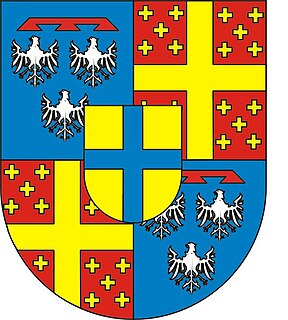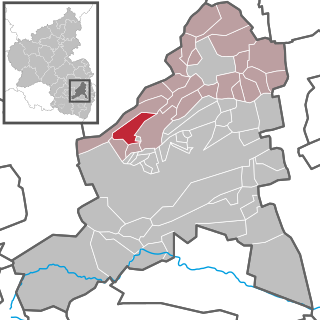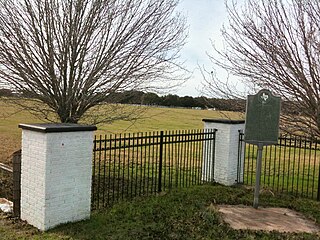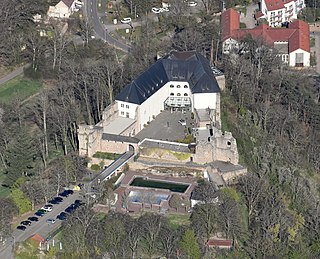
Westerburg is a small town of roughly 6,000 inhabitants in the Westerwaldkreis in Rhineland-Palatinate, Germany. The town is named after the castle built on a hill above the mediaeval town centre

The House of Leiningen is the name of an old German noble family whose lands lay principally in Alsace, Lorraine and the Palatinate. Various branches of this family developed over the centuries and ruled counties with Imperial immediacy.

Leiningen-Westerburg was an historic state of the Holy Roman Empire, located in the vicinity of Leiningen and Westerburg in what is now the German state of Rhineland-Palatinate.

Carlsberg is an Ortsgemeinde – a municipality belonging to a Verbandsgemeinde, a kind of collective municipality – in the Bad Dürkheim district in Rhineland-Palatinate, Germany.

The Mainzer Adelsverein at Biebrich am Rhein, better known as the Mainzer Adelsverein, organized on April 20, 1842, was a colonial attempt to establish a new German settlement within the borders of Texas.

Neuleiningen Castle is a ruin on the eastern edge of the Palatinate Forest in the state of Rhineland-Palatinate in Germany in the municipality of Neuleiningen in the Bad Dürkheim district. It was built in 1238-41 by Count Frederick III of Leiningen. The French destroyed it in 1690 and it has lain in ruins since that time.
Leiningen-Westerburg was an historic state of the Holy Roman Empire, located in the vicinity of Leiningen and Westerburg in what is now the German state of Rhineland-Palatinate.

Károly Leiningen-Westerburg was a German honvéd general in the Hungarian Army, and a member of the German House of Leiningen. He was executed for his part in the Hungarian Revolution of 1848, and is considered one of the 13 Martyrs of Arad.

The County of Leiningen consists on a group of counties, which were ruled by the Leiningen family.

Nassau Plantation was a 4,428 acres endeavor purchased by the Adelsverein on January 9, 1843, in Fayette County, Texas, near what is now Round Top. A Texas State Historical Marker was installed in 1968, Marker 3550.

Christian Ernest, Count of Stolberg-Wernigerode, was a German politician and a member of the House of Stolberg. From 1710 to 1771 he governed County of Wernigerode in the Harz mountains, which in 1714 became a dependency of Brandenburg-Prussia.

Frederick I of Hesse-Homburg, was the first Landgrave of Hesse-Homburg and founder of the eponymous family line.
Margaret Elisabeth of Leiningen-Westerburg, was a Countess of Leiningen and regent of the Landgraviate of Hesse-Homburg during the minority of her sons from 1638.
Bernardine of Lippe (1563-1628) was a Countess of Lippe by birth and by marriage Countess of Leiningen-Leiningen.
Louis, Count Leiningen-Westerburg (1557–1622) was a German nobleman. He was a member of the House of Leiningen and was the ruling count of Leiningen-Leiningen from 1597 until his death.

Altleiningen is a castle in the Palatinate Forest in Germany. It lies in the parish of Altleiningen in the county of Bad Dürkheim in the German state of Rhineland-Palatinate.
Johanna Walpurgis of Leiningen-Westerburg, was a German noblewoman member of the House of Runkel and by marriage Duchess of Saxe-Weissenfels.

The Barony of Westerburg, a small principality around the present day town of Westerburg in the Westerwald mountains of Germany, is first recorded in 1209. The eponymous castle, which had probably been built earlier than when it was mentioned for the first time in 1192, was the family seat of the lords of Westerburg, a branch of the lords of Runkel.

Schloss Westerburg, first recorded in 1192, but probably built earlier, is situated in the town of Westerburg in the forested hills of the Westerwald and is on the site of an older castle dating to the 12th century. The latter belonged to the counts of Leiningen but was transferred to the House of Runkel as the result of the marriage of Siegfried III of Runkel to a daughter of the House of Leiningen in the early 13th century. In the first half of the 13th century the castle was the seat of the lords of Westerburg, who had split off from the House of Runkel by 1288 with Henry I of Westerburg.
Margarete von Leiningen-Westerburg-Neuleiningen (1694-1771), was a countess regnant of Leiningen from 1726.